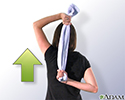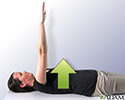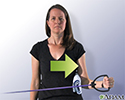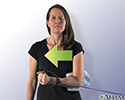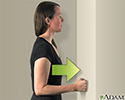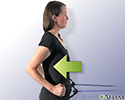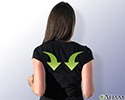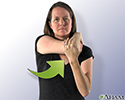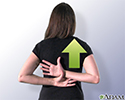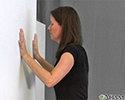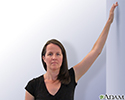Rotator cuff exercises
Shoulder exercises
Your Shoulder Joint
The rotator cuff is a group of muscles and tendons that attach to the bones of the shoulder joint, allowing the shoulder to move and keeping it stable.
The tendons of the rotator cuff pass underneath a bony area on their way to attaching to the top of the arm bone. These tendons join together to form a cuff that surrounds the shoulder joint. This helps keep the joint stable and allows the arm bone to move on the shoulder bone.
Injury to these tendons may result in:
- Rotator cuff tendinitis, which is irritation and swelling of these tendons
- A rotator cuff tear, which occurs when one of the tendons is torn due to overuse or injury
These injuries often lead to pain, weakness, and stiffness when you use your shoulder. A key part in your recovery is doing exercises to make the muscles and tendons in your joint stronger and more flexible.
Your doctor may refer you to a physical therapist to treat your rotator cuff. A physical therapist is trained to help improve your ability to do the activities you want.
Evaluating Your Shoulder
Before treating you, a doctor or therapist will evaluate your body mechanics. The therapist may:
- Watch how your shoulder moves as you perform activities, including your shoulder joint and your shoulder blade
- Observe your spine and posture as you stand or sit
- Check the range of motion of your shoulder joint and spine.
- Test different muscles for weakness or stiffness
- Check to see which movements seem to cause or worsen your pain
After testing and examining you, your doctor or physical therapist will know which muscles are weak or too tight. You will then start a program to stretch your muscles and make them stronger.
Exercises for Your Shoulder
The goal is for you to function as well as possible with little or no pain. To do this, your physical therapist will:
- Help you strengthen and stretch the muscles around your shoulder
- Teach you proper ways to move your shoulder, for everyday tasks or sports activities
Before doing exercises at home, ask your doctor or physical therapist to make sure you are doing them properly. If you have pain during or after an exercise, you may need to change the way you are doing the exercise.
Most exercises for your shoulder either stretch or strengthen (make stronger) the muscles and tendons of your shoulder joint.
Exercises to stretch your shoulder include:
-
Stretching the back of your shoulder (posterior stretching)
Stretching the back of your shoulder (p...
Stretching the back of your shoulder is an exercise that stretches the back part of your injured shoulder joint.
Read Article Now Book Mark Article -
Hand up your back stretch (anterior shoulder stretch)
Hand up your back stretch (anterior sho...
The hand up your back stretch is an exercise that stretches the anterior, or front, part of your shoulder.
Read Article Now Book Mark Article -
Anterior shoulder stretch - towel
Anterior shoulder stretch - towel
The anterior shoulder stretch is an exercise that stretches the anterior, or front, part of your shoulder.
Read Article Now Book Mark Article -
Pendulum exercise
Pendulum exercise
The pendulum exercise stretches the joint capsule of your shoulder joint to keep it from getting stiff. Avoid this exercise if you have back pain....
Read Article Now Book Mark Article -
Wall stretches
Wall stretches
Wall stretches are exercises that help make your injured shoulder joint more flexible.
Read Article Now Book Mark Article
Exercises to strengthen your shoulder:
-
Internal rotation exercise - with band
Internal rotation exercise - with band
Internal rotation with a band is an exercise that strengthens or tones the muscles that help rotate your shoulder inward, or towards your body....
Read Article Now Book Mark Article -
External rotation exercise - with band
External rotation exercise - with band
External rotation with a band is an exercise that strengthens or tones the muscles that help rotate your shoulder inward, or towards your body....
Read Article Now Book Mark Article -
Isometric shoulder exercises
Isometric shoulder exercises
Isometric shoulder exercises strengthen and tone the muscles in your shoulder.
Read Article Now Book Mark Article -
Wall push-ups
Wall push-ups
Wall push-ups are exercises that stretch the muscles and joint capsule of your shoulder joint.
Read Article Now Book Mark Article -
Shoulder blade (scapular) retraction - no tubing
Shoulder blade (scapular) retraction - ...
The shoulder blade retraction with no tubing exercise stretches the muscles that hold your shoulder blade (scapula).
Read Article Now Book Mark Article -
Shoulder blade (scapular) retraction - tubing
Shoulder blade (scapular) retraction - ...
The shoulder blade retraction with tubing exercise stretches the muscles that hold your shoulder blade (scapula).
Read Article Now Book Mark Article -
Arm reach
Arm reach
The arm reach is an exercise that strengthens the muscles that hold your should blade (scapula).
Read Article Now Book Mark Article
References
O'Brien MJ, Leggin BG, Williams GR. Rotator cuff tendinopathies and tears: surgery and therapy. In: Skirven TM, Osterman AL, Fedorczyk JM, Amadio PC, eds. Rehabilitation of the Hand and Upper Extremity . 6th ed. Philadelphia, PA: Elsevier Mosby; 2011:chap 88.
Rudolph GH, Moen T, Garofalo R, Krishnan SG. Rotator cuff and impingement. In: Miller MD, Thompson SR, eds. DeLee and Drez's Orthopaedic Sports Medicine: Principles and Practice . 4th ed. Philadelphia, PA: Elsevier Saunders; 2015:chap 52.
Whittle S, Buchbinder R. In the clinic. Rotator cuff disease. Ann Intern Med . 2015;162:ITC1-15. PMID: 25560729 www.ncbi.nlm.nih.gov/pubmed/25560729 .
-
Anterior shoulder stretch - illustration
The anterior shoulder stretch is an exercise that stretches the anterior, or front, part of your shoulder. anterior shoulder stretch
Anterior shoulder stretch
illustration
-
Arm reach - illustration
The arm reach is an exercise that strengthens the muscles that hold your should blade (scapula). arm reach
Arm reach
illustration
-
External rotation with band - illustration
External rotation with a band is an exercise that strengthens or tones the muscles that help rotate your shoulder outward, or away from your body. External rotation with a band
External rotation with band
illustration
-
Internal rotation with band - illustration
Internal rotation with a band is an exercise that strengthens or tones the muscles that help rotate your shoulder inward, or towards your body. Internal rotation with a band
Internal rotation with band
illustration
-
Isometric - illustration
Isometric shoulder exercises strengthen and tone the muscles in your shoulder. Isometric shoulder exercises
Isometric
illustration
-
Pendulum exercise - illustration
The pendulum exercise stretches the joint capsule of your shoulder joint to keep it from getting stiff. Avoid this exercise if you have back pain. pendulum exercise
Pendulum exercise
illustration
-
Shoulder blade retraction with tubing - illustration
The shoulder blade retraction with tubing exercise stretches the muscles that hold your shoulder blade (scapula). shoulder blade retraction with tubing exercise
Shoulder blade retraction with tubing
illustration
-
Shoulder blade retraction - illustration
The shoulder blade retraction with no tubing exercise stretches the muscles that hold your shoulder blade (scapula). shoulder blade retraction
Shoulder blade retraction
illustration
-
Stretching back of shoulder - illustration
Stretching the back of your shoulder is an exercise that stretches the back part of your injured shoulder joint. Stretching the back of your shoulder
Stretching back of shoulder
illustration
-
Up the back stretch - illustration
The hand up your back stretch is an exercise that stretches the anterior, or front, part of your shoulder. hand up your back stretch
Up the back stretch
illustration
-
Wall push-up - illustration
Wall push-ups are exercises that stretch the muscles and joint capsule of your shoulder joint. Wall push-ups
Wall push-up
illustration
-
Wall stretch - illustration
Wall stretches are exercises that help make your injured shoulder joint more flexible. Wall stretches
Wall stretch
illustration
-
Anterior shoulder stretch - illustration
The anterior shoulder stretch is an exercise that stretches the anterior, or front, part of your shoulder. anterior shoulder stretch
Anterior shoulder stretch
illustration
-
Arm reach - illustration
The arm reach is an exercise that strengthens the muscles that hold your should blade (scapula). arm reach
Arm reach
illustration
-
External rotation with band - illustration
External rotation with a band is an exercise that strengthens or tones the muscles that help rotate your shoulder outward, or away from your body. External rotation with a band
External rotation with band
illustration
-
Internal rotation with band - illustration
Internal rotation with a band is an exercise that strengthens or tones the muscles that help rotate your shoulder inward, or towards your body. Internal rotation with a band
Internal rotation with band
illustration
-
Isometric - illustration
Isometric shoulder exercises strengthen and tone the muscles in your shoulder. Isometric shoulder exercises
Isometric
illustration
-
Pendulum exercise - illustration
The pendulum exercise stretches the joint capsule of your shoulder joint to keep it from getting stiff. Avoid this exercise if you have back pain. pendulum exercise
Pendulum exercise
illustration
-
Shoulder blade retraction with tubing - illustration
The shoulder blade retraction with tubing exercise stretches the muscles that hold your shoulder blade (scapula). shoulder blade retraction with tubing exercise
Shoulder blade retraction with tubing
illustration
-
Shoulder blade retraction - illustration
The shoulder blade retraction with no tubing exercise stretches the muscles that hold your shoulder blade (scapula). shoulder blade retraction
Shoulder blade retraction
illustration
-
Stretching back of shoulder - illustration
Stretching the back of your shoulder is an exercise that stretches the back part of your injured shoulder joint. Stretching the back of your shoulder
Stretching back of shoulder
illustration
-
Up the back stretch - illustration
The hand up your back stretch is an exercise that stretches the anterior, or front, part of your shoulder. hand up your back stretch
Up the back stretch
illustration
-
Wall push-up - illustration
Wall push-ups are exercises that stretch the muscles and joint capsule of your shoulder joint. Wall push-ups
Wall push-up
illustration
-
Wall stretch - illustration
Wall stretches are exercises that help make your injured shoulder joint more flexible. Wall stretches
Wall stretch
illustration
Review Date: 5/9/2015
Reviewed By: C. Benjamin Ma, MD, Assistant Professor, Chief, Sports Medicine and Shoulder Service, UCSF Department of Orthopaedic Surgery, San Francisco, CA. Also reviewed by David Zieve, MD, MHA, Isla Ogilvie, PhD, and the A.D.A.M. Editorial team.

